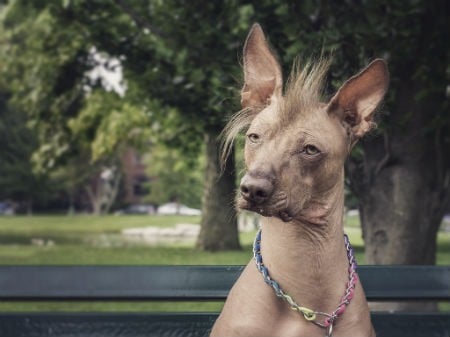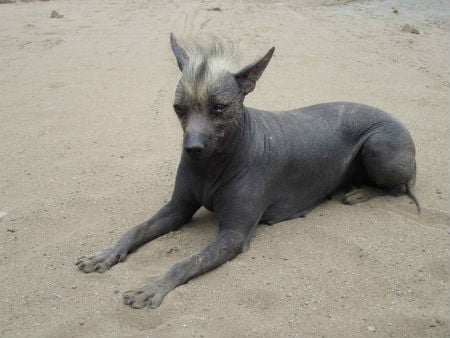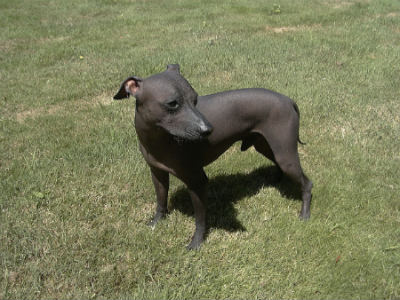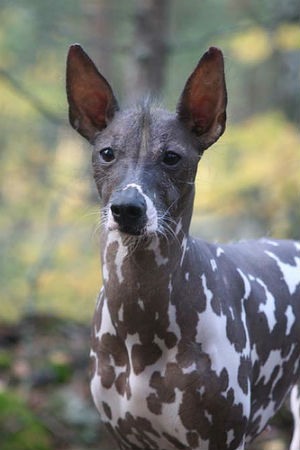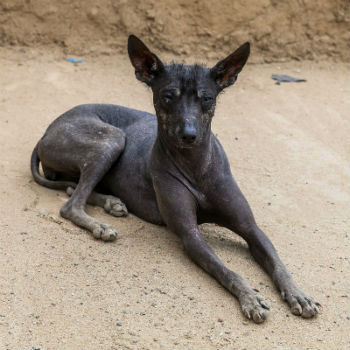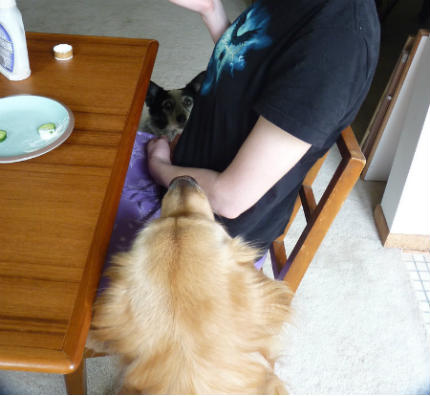Today we are going to meet a breed of dog that you may not have heard of before. The
Peruvian hairless dog (also known as Peruvian dog, Viringo dog or simply Viringo) is
an ancient breed of hairless dog of Peruvian origin characterized by its warm skin to the touch. This dog is a pride for the Peruvian nation, and is considered National Heritage according to the nation's decree 27537 published in 2001. Registered as a pure breed since 1995, when the
International Cynological Federation (FCI) recognized and registered it in its breed nomenclature under number 310. The Peruvian Dog is also seen as
an exotic breed and is highly recommended as a companion animal for those people who are allergic to dog hair.
Origin of the Peruvian Dog
This breed was first recorded in the early 16th century, when Spanish explorers were invited to the homes of nobles of the Inca empire. The Incas called this dog “
allqu ,” which literally meant “dog.” It played an important role within this society, even becoming part of local customs and stories and myths of the region.
The Moche (or Mochica) culture called these dogs “
Viringos ” and they were responsible for distributing this name. Even today, in the regions between Piura and Trujillo,
they are called Perros Viringos . Regarding its antiquity, archaeologists have discovered bones of this breed of dog that date back to pre-Columbian times. However, these appear on ceramics from many pre-Inca cultures throughout Peru. According to these pieces, the Peruvian dog could have made its appearance between 300 BC and 1460. Despite enjoying
great popularity in its country of origin , the Peruvian dog (like many other hairless breeds)
is not well known in the world. rest of the world , especially in Europe, where they are considered exotic dogs.
Main characteristics of the Peruvian dog
They are distinguished among other hairless dogs mainly by being thin, slender, with elegant lines, long legs and refined lines. Among the key data of this breed are:
-
Morphology : Hairless, thin and slender.
-
Size : Between 50 and 65 cm.
-
Weight : From 13 to 25 Kg.
-
Average life expectancy : Varies between 10 and 12 years.
-
Eyes : Round and dark. Hypersensitive to light.
-
Ears : Raised.
-
Tail : Fine, long and hairless.
-
Legs : Long and thin.
-
Skin : Soft, flexible and warm.
Their absence of hair is due to a genetic alteration they have, since it is proven that it is normal for dogs to have fur, since it protects and insulates their skin from the environment. This is one of the reasons why the Viringo dog
is more prone to getting sick than other dogs . Another curious fact is that
not all Peruvian dogs are completely bald . Some have a little hair on their head, others have a few strands distributed throughout their body, and there is the bald variety, which is the most popular. As for its color, there is an immense variety that goes from slate black to chestnut brown, through gray scales. Some specimens have white or pink spots on their skin, generally on the legs, head or chest.
Behavior and character of the Peruvian Dog
In general, they tend to be
very sociable dogs , both with humans and other animals. They get along wonderfully with children and are usually very faithful companions. His behavior could be characterized as intelligent, curious, witty, calm and fun. In addition, its friendly and affectionate character makes it
ideal as a pet for any dog lover .
Lifestyle of the Peruvian Dog
The Viringo dog is a suitable companion for any type of home, including apartments. They are usually indoor dogs and it is recommended that they sleep inside the house, which does not exclude them from walks and other outdoor activities. They are animals with very delicate skin due to their lack of hair, so it is not recommended to let them go out too much on the hottest days of summer or the coldest days of winter, as their skin can burn, irritate or crack. It is recommended to take these hairless dogs for a daily walk and, if possible, accompany them with some games and some socialization with other dogs.
Health and care
Since it does not have hair, certain special care is necessary to keep the Viringo dog in good health.
General health of the Peruvian dog
Sadly,
the Peruvian Hairless Dog is very prone to different ailments and genetic diseases due to the inbreeding of this breed. The most common ailments usually occur in the teeth, such as tooth loss and jaw malformations. For this reason we must be attentive to any complaint or ailment that our companion may present and take him to a veterinarian to find the problem and solve it. You can also consult with the veterinarian preventively to include a supply of calcium in the viringo dog's diet to extend the life of its teeth. In addition, we must be careful to comply with the entire vaccination schedule recommended by the veterinarian, and keep the necessary deworming up to date.
Peruvian dog skin care
The skin of the Peruvian hairless dog is extremely sensitive. If it is unprotected, it is very prone to sunburn, dryness or cracking. For this reason, it is recommended to apply sunscreen on your skin before going for a walk during the summer. In addition, these walks should be done in the morning or afternoon as much as possible to avoid the hours of greatest sun exposure. This dog is very sensitive to low temperatures, so during the winter it must be kept warm to prevent it from getting sick. For walks during this time of year, it is best to wear a piece of clothing for dogs to protect them from the cold.
Bathing and grooming the Peruvian dog
As for bathing, this should be
every 15 days at most . The Peruvian dog should be bathed with warm water and appropriate soap. After bathing, it is recommended to apply some type of moisturizing oil to improve the texture of your skin, which is generally dry. In some cases of greater dryness, it is good to apply moisturizing creams, but not in excess because it could endanger some glands in the skin of the viringo dog and cause rashes on its skin. To clean your ears, it is advisable to use a cotton ball moistened with a little water and rub the inside of the ear gently without letting liquid fall into the inside of the ear. Lagañas can also be cleaned in a similar way.
Peruvian Dog Walks
Despite not needing a large amount of exercise,
it is necessary to take the Peruvian dog for a daily walk . This reinforces the animal's social nature, as it gets used to seeing more people and other animals. When walking you should take into account the care of their skin, avoiding excessive sun exposure or too much cold. It is also a good idea to bring a soft toy to exercise the Peruvian dog during your walk. If the Peruvian dog does not do any exercise, it can transform its energy into anxiety and stress, which can end in negative attitudes such as aggressive and/or destructive episodes.
Feeding of the Peruvian Dog
This must be as balanced as possible so that the Peruvian dog can have the necessary amounts of nutrients to be in the best condition. It is advisable to use good quality food to take care of your companion's health. Along with food, you can give a little fresh water to help better digestion.
Reproduction of the Peruvian Dog
This breed generally does not have problems when reproducing, although there may be exceptions. The largest Peruvian dog specimens usually have more offspring than the smaller ones. During pregnancy it is advisable to keep the female in a warm environment, with temperatures no lower than 23 °C. It is also very important to feed her correctly, with good quality food, to ensure the health of her and the puppies. Even if two hairless Peruvian dogs are crossed, there is always the probability that
one of the pups could be born with some hair , although this probability is not too high. The haired variety of the Peruvian dog is quite appreciated by the breeders of these dogs because they have stronger genes than the hairless Peruvian dog and do not suffer from the same conditions as these, such as premature loss of teeth. The crossing of a Peruvian hairless dog with a Peruvian dog with hair generates a litter in which, generally, half of the puppies are born bald and the other half with hair. Puppies from the crossing of a hairless Peruvian dog and a haired one tend to get sick less than puppies whose parents are only hairless Peruvian dogs.
Why does the Peruvian Hairless Dog have no fur?
The person responsible for this mutation in the Peruvian dog is the “
foxi3 ” gene. This gene is also responsible for the absence of hair in other hairless breeds such as the Xoloitzcuintle or the Chinese Crested. According to Pedro Weiss, a canine researcher, the absence of hair in the Peruvian Dog is a consequence of suffering from
canine ectodermal hypoplasia syndrome . Syndrome also responsible for the fragility of the teeth of the Peruvian Dog.
Interesting facts about the Peruvian Dog
Here are some false facts and myths about the Peruvian Dog that you probably don't know.
It is believed that their body temperature is higher
Completely false. It has already been shown that
their body temperature is the same as that of other dogs . What happens is that, due to its absence of hair, the transfer of heat from its body to another medium (your hand, for example) is done more directly and therefore it feels warmer.
They were considered “medicinal dogs.”
As it was believed that these canines were warmer than other dogs, they were used by the ancient Incas to
treat cold-related illnesses . For example, if you suffered from a cough or flu, it was recommended to sleep with your Peruvian dog hugged to your chest to alleviate the illness. Nowadays it has been proven that all this is false, although they are still dogs recommended for people with allergies or who suffer from asthma thanks to their lack of hair.
Adapts to any climate
Under certain care,
the Peruvian dog can adapt to any climate . This is the reason why they are so accepted globally and considered so exotic in certain regions.
Does not have premolars
This is a consequence of the same gene that inhibits fur growth in the dog, but it is the easiest way to verify that the Peruvian dog is pure blood and is not a “mixture.”
Different skin tones
You can find Peruvian dogs from light blonde to slate black, through shades of brown and gray. It is also worth noting that the skin color of the Peruvian Hairless Dog can change depending on the amount of sun it is exposed to.
In conclusion
The
Peruvian Hairless Dog or Viringo dog is a friendly companion that you will have to take good care of to keep it as healthy as possible. Remember to take special care during the summer and winter when walking your new friend, as his skin could dry out, burn or suffer lacerations. Its sociable, curious and friendly character makes it
excellent to have at home with children , even if they suffer from allergies or asthma. If you decide to adopt a Peruvian dog, keep in mind that every effort you make to care for it will be returned in the form of love, companionship and loyalty.
More about dogs:

